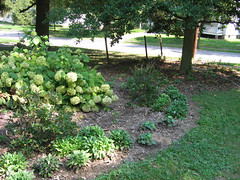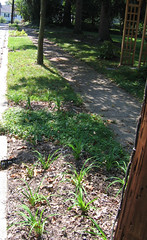Gimme Leaves!
Today feels fall-ish and I’m greedily eyeing the leaves on our neighbor’s trees. I can’t get enough leaves. Our trees are mostly evergreens. The honeysuckles’ leaf fall is negligible and our hackberry tree drops most of its leaves in Mary’s yard. Our sweet gum drops a good portion of leaves, but not nearly enough for my nefarious purposes. As the season advances, I will be canvassing the block for my neighbors’ leaves so that I can kill more grass.
 Last fall, I spread Tim’s and my eastern neighbor’s leaves along the southeast edge of our front yard. Two hollies, an enormous euonymus, and a floppy Annabelle hydrangea line the fence separating our yard from the neighbor’s. The ground cover was a mix of grass, violets, henbit, and ivy. A generous layer of leaves (roughly 4 – 6 inches) effectively smothered the ground cover and created a shade garden. I have had to remove a few survivors (mostly the damn pernicious violets), but, for the most part, I am a convert to this simple way of turning lawn into garden.
Last fall, I spread Tim’s and my eastern neighbor’s leaves along the southeast edge of our front yard. Two hollies, an enormous euonymus, and a floppy Annabelle hydrangea line the fence separating our yard from the neighbor’s. The ground cover was a mix of grass, violets, henbit, and ivy. A generous layer of leaves (roughly 4 – 6 inches) effectively smothered the ground cover and created a shade garden. I have had to remove a few survivors (mostly the damn pernicious violets), but, for the most part, I am a convert to this simple way of turning lawn into garden.
 This year, I plan on ridding the yard of the grass on both sides of the sidewalk. I’ve already begun planting in the hell strip, using the tedious sod-removal method. The other side of the sidewalk is heavily shaded by our two Norway spruce and a hackberry tree. The grass is sparse and removing it will be a blessing. I plan on spreading a thick leaf mat in the hell strip, beneath the Norway spruce and hackberry tree, and over the entire north corner of the back yard.
This year, I plan on ridding the yard of the grass on both sides of the sidewalk. I’ve already begun planting in the hell strip, using the tedious sod-removal method. The other side of the sidewalk is heavily shaded by our two Norway spruce and a hackberry tree. The grass is sparse and removing it will be a blessing. I plan on spreading a thick leaf mat in the hell strip, beneath the Norway spruce and hackberry tree, and over the entire north corner of the back yard.
The only drawback to using fall leaves as a smothering mulch is that, initially, they tend to blow away. The dry leaves shift out of my artfully arranged piles and I am compelled to trudge outside with a rake to reform the edges of my future beds. As the season progresses, the leaves lock together into a soggy mat. However, those first few weeks are difficult. Add whooshing cars, doodling doggies, and errant bicycles, and the leaves I’ve carefully arranged in the hellstrip don’t have a chance.
Thankfully, I heard about a product called Leaf Lock. Derived from corn solids, it combines with water to form a “shell” that prevents a leaf pile from blowing away. I haven’t checked at the local big box stores yet, but I’ve heard that it is only available from Amazon. I suppose I’d better place my order before the fall rush. I plan on using this product on the leaf piles in the hellstrip and anywhere else that I need to maintain a hard edge.
I also use fallen leaves as a mulch in my garden beds. Contrary to popular opinion, I’ve found that they do not smother perennials, even when applied whole. I do take care with the low growers and I do not cover the evergreen groundcovers at all. Sweet woodruff seemed to like a very thick layer last fall, provided it was pushed aside in the spring. Most perennials, though, send up strong, vigorous shoots in the spring that easily penetrate the weathered leaf mat.
While most people are cursing the leaves falling from their trees, I’ll be volunteering to rake my neighbors’ yards and snatching full leaf bags from the curb. (Strangely, Mike will help me drag leaf bags home but strongly objects to my plucking newspapers from recycle bins.) I’ll smother the lawn and mulch my beds with the excess. If I am lucky enough to still have leaves left over, I will try the black plastic bag composting method. Fall, leaves, fall!
 Last fall, I spread Tim’s and my eastern neighbor’s leaves along the southeast edge of our front yard. Two hollies, an enormous euonymus, and a floppy Annabelle hydrangea line the fence separating our yard from the neighbor’s. The ground cover was a mix of grass, violets, henbit, and ivy. A generous layer of leaves (roughly 4 – 6 inches) effectively smothered the ground cover and created a shade garden. I have had to remove a few survivors (mostly the damn pernicious violets), but, for the most part, I am a convert to this simple way of turning lawn into garden.
Last fall, I spread Tim’s and my eastern neighbor’s leaves along the southeast edge of our front yard. Two hollies, an enormous euonymus, and a floppy Annabelle hydrangea line the fence separating our yard from the neighbor’s. The ground cover was a mix of grass, violets, henbit, and ivy. A generous layer of leaves (roughly 4 – 6 inches) effectively smothered the ground cover and created a shade garden. I have had to remove a few survivors (mostly the damn pernicious violets), but, for the most part, I am a convert to this simple way of turning lawn into garden. This year, I plan on ridding the yard of the grass on both sides of the sidewalk. I’ve already begun planting in the hell strip, using the tedious sod-removal method. The other side of the sidewalk is heavily shaded by our two Norway spruce and a hackberry tree. The grass is sparse and removing it will be a blessing. I plan on spreading a thick leaf mat in the hell strip, beneath the Norway spruce and hackberry tree, and over the entire north corner of the back yard.
This year, I plan on ridding the yard of the grass on both sides of the sidewalk. I’ve already begun planting in the hell strip, using the tedious sod-removal method. The other side of the sidewalk is heavily shaded by our two Norway spruce and a hackberry tree. The grass is sparse and removing it will be a blessing. I plan on spreading a thick leaf mat in the hell strip, beneath the Norway spruce and hackberry tree, and over the entire north corner of the back yard.The only drawback to using fall leaves as a smothering mulch is that, initially, they tend to blow away. The dry leaves shift out of my artfully arranged piles and I am compelled to trudge outside with a rake to reform the edges of my future beds. As the season progresses, the leaves lock together into a soggy mat. However, those first few weeks are difficult. Add whooshing cars, doodling doggies, and errant bicycles, and the leaves I’ve carefully arranged in the hellstrip don’t have a chance.
Thankfully, I heard about a product called Leaf Lock. Derived from corn solids, it combines with water to form a “shell” that prevents a leaf pile from blowing away. I haven’t checked at the local big box stores yet, but I’ve heard that it is only available from Amazon. I suppose I’d better place my order before the fall rush. I plan on using this product on the leaf piles in the hellstrip and anywhere else that I need to maintain a hard edge.
I also use fallen leaves as a mulch in my garden beds. Contrary to popular opinion, I’ve found that they do not smother perennials, even when applied whole. I do take care with the low growers and I do not cover the evergreen groundcovers at all. Sweet woodruff seemed to like a very thick layer last fall, provided it was pushed aside in the spring. Most perennials, though, send up strong, vigorous shoots in the spring that easily penetrate the weathered leaf mat.
While most people are cursing the leaves falling from their trees, I’ll be volunteering to rake my neighbors’ yards and snatching full leaf bags from the curb. (Strangely, Mike will help me drag leaf bags home but strongly objects to my plucking newspapers from recycle bins.) I’ll smother the lawn and mulch my beds with the excess. If I am lucky enough to still have leaves left over, I will try the black plastic bag composting method. Fall, leaves, fall!


5 Comments:
One of the nice things about living in the woods is that I always have plenty of leaves with which to mulch. Like you, I rake the leaves from my lawn onto the perennial beds and they do just fine. In the spring, I toss them over the fence and they keep the weeds down behind the fence. The woods, of course, gratefully, don't need raking! "-)
My evening primroses were the only plant that died down when I settled leaves around them for mulch, last Fall. Everyone else was a happy camper, still, come Spring.
Every season I learn something new from you! Thank you! I will love my falling leaves now!
The leaf harvest is my favorite of the year! If you can be bothered, chop up the leaves first and they'll be less likely to blow away. I like to use my favorite tool, the leaf vac, for this. Since you don't have any of your own leaves, you probably don't have a beloved leaf vac. The lawnmower or weed-whacker in a large trashcan work just as well.
It seems that most people hate leaves--especially when they clog their gutters. Your post, however, has given me a new way of looking at leaves as an easy and extremely cost-effective way to convert a lawn into new space for a garden.
Post a Comment
<< Home